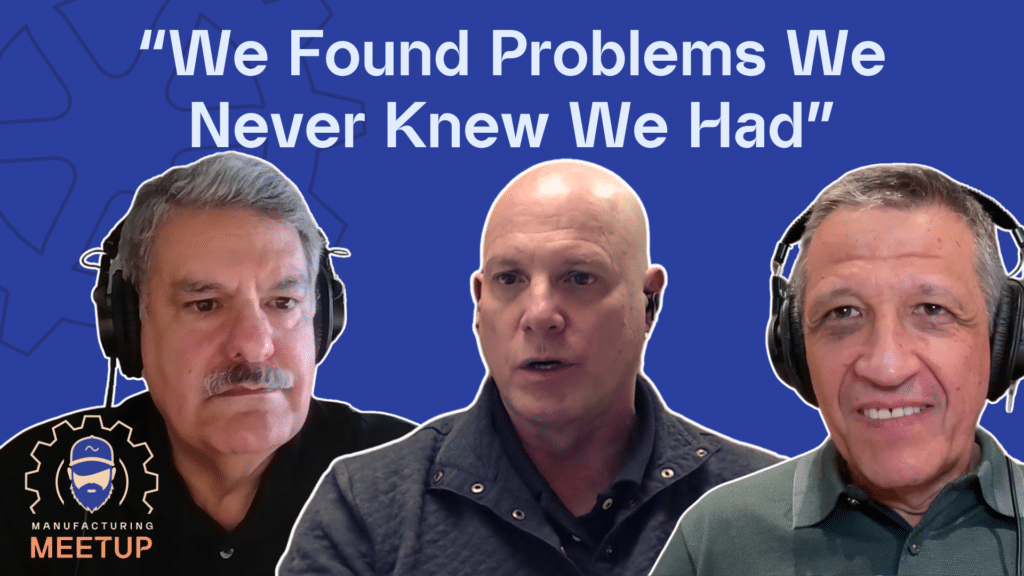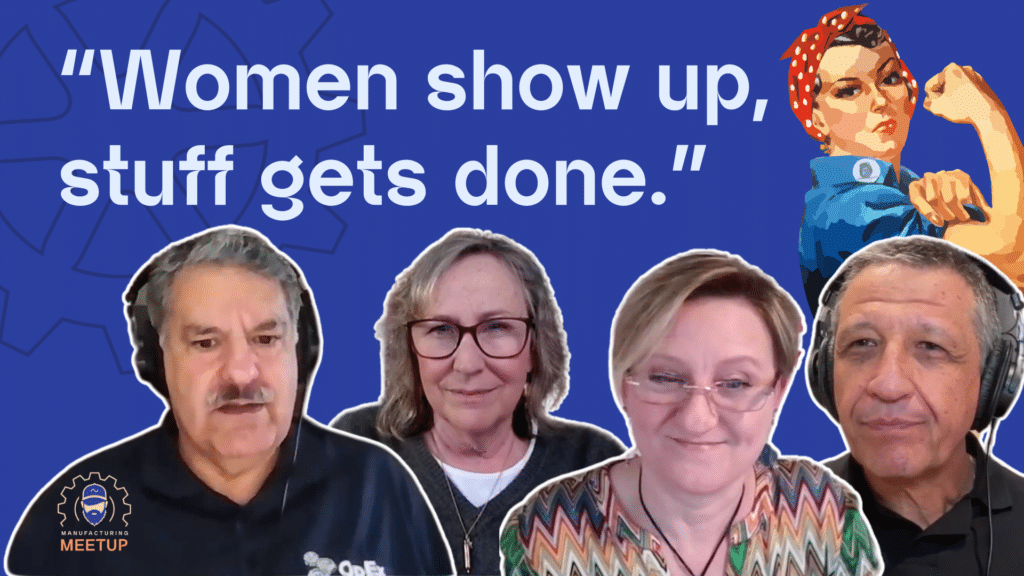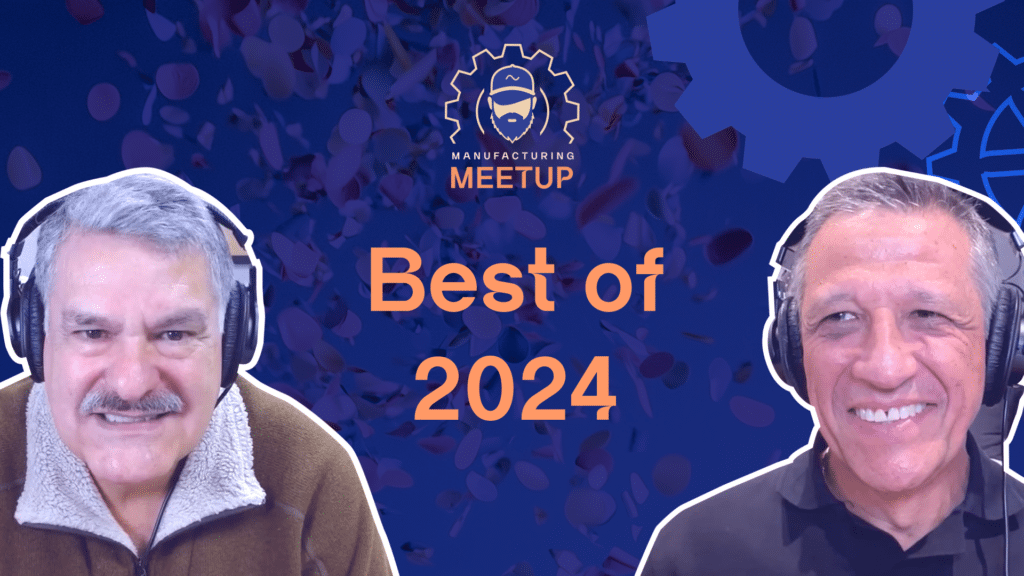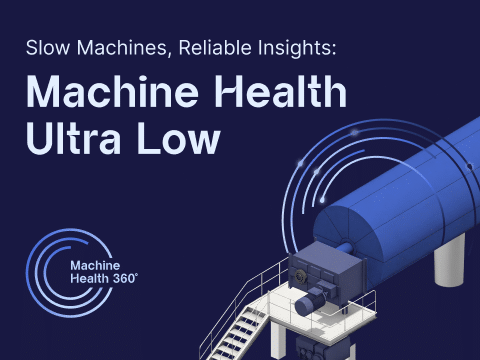Breaking down the alphabet soup of operational excellence
In this episode, Ed and Alvaro talk about the fundamental building blocks of operational excellence – along with the alphabet soup of acronyms that come with these methods of managing your manufacturing.
Ed also drops a truth bomb: nothing is as silent as yesterday’s applause. (So you have to keep improving!)
Links to news stories mentioned in this episode:
Artificial Intelligence set to transform beverage industry
Sikich Manufacturing Industry Pulse
To keep the conversation going:
Email us: mmu@augury.com
Find us on The Endpoint: endpoint.augury.com
Full Transcript
Ed Ballina
Great. Well, hello there, fellow manufacturing leaders. I’m Ed Ballina.
Alvaro Cuba
Hey guys, I’m Alvaro Cuba. Great to have you with us in this episode. So what’s about the news? What happened this week Ed?
Ed Ballina
Well, very, very unexpectedly, I was able to attend a really fun activity with the Augurians. So I went up spending a little bit of time at power week camp with the Augury team. Me and 150 of my best Augurian friends, or thereabouts, got to meet some great people.
Alvaro Cuba
Sounds very exciting.
Ed Ballina
It was a lot of fun, you know, many of our friends that we’ve only seen on calls, I was able to meet in the real world and that was that was fun. It was a little rustic. It was a camp environment. Really, really cool. And I, you know, I always like to poke a little fun at things. So while I was there, I happened to get a trail cam video of a black bear going through some hunting property that I own. And it was a really cool shot.
Alvaro Cuba
Hahaha!
Ed Ballina
And it was kind of like just early in the morning. So it was almost black and whitish. So I said, I think I see an opportunity here. So I walked over to one of our fellow Augurians that I know well. And I said, hey, I was in my bed last night. I kept on hearing the scratching sound and I really didn’t know what it was. And I went outside and I showed you, she goes, where was that?
Alvaro Cuba
and then you created a riot.
That’s it.
Ed Ballina
Right outside like your front door? I go, yeah, pretty much. I quickly had to backpedal because I started seeing the fear in the eyes. I said, no, no, no, no, it’s about five hours south of here. But a terrific experience. We talked a lot about AI. We talked about the new product offerings that Augury’s coming up with, some real exciting stuff. But more important than anything, I got the opportunity to build some really cool relationships with a bunch of folks from Augury So.
Alvaro Cuba
Hahaha.
Ed Ballina
I just want to give a big shout out. Great people. Absolutely. And I can tell you they are a lot of fun to be with. So, but they work hard. Like eight thirty, nine o ‘clock at night, we’re still doing stuff. So anyway, that was my weekend. Well, there might’ve been a higher level of partying as the night got on. How about you? Where were you jetting off to?
Alvaro Cuba
Always the best part. The people part, always the best part.I also had a very, very nice week. I was in Peru. Yeah, I was visiting family, friends and part of the journey. And, you know, you go there and it’s, in Peru,
Ed Ballina
Nice!
Alvaro Cuba
A lot of things are around food. So we had breakfast, lunch and dinner booked every single day, trying to meet with as much as friends and much as family and exchanging experiences. And it’s the kind of week that you end up and you feel re -energized and fulfilled. Yes, it was very good. And on the…
Ed Ballina
Yes. Yeah, fulfilled.
Alvaro Cuba
On the professional part, I also had the chance to visit a couple of manufacturing plants out there. And I was very glad to see they are starting to put operational excellence and also investing in AI and robotics and some, but the important thing is in my experience before, it was kind of not a constant effort, no.
Ed Ballina
Cool.
Alvaro Cuba
Some here, some there, not a consistency across. But I was very happy to see projects that are going on for three, four years, results not like this, but starting to get continuous improvement over time. So I was very pleased to see that progress. So all in all, very, very nice week and I’m back
Ed Ballina
Wow.
Alvaro Cuba
Great visit. Completely re -energized.
Ed Ballina
Rejuvenate. You know what’s funny about the way that progression has happened in some of these other countries? Historically, I think we’ve seen kind of the leaders in technology, right, launch these new initiatives that may take decades to find themselves into places like Latin America or the Middle East, et cetera. Some, which you might call less developed, but with AI, and some of that was because labor arbitrage, right?
When you can get very low labor rates, some of this technology doesn’t pay out. But I see such a broad interest and adaptation of AI, right? And, you know, 4.0 and all the other alphabet soup that we throw around that I think it’s leapfrogged much quicker than what the historical progression process is for manufacturing improvements. So I think that’s huge.
Alvaro Cuba
And I think that you bring a great point, but I think it’s also because different than the previous waves of technology, this one is so easy to implement. It has almost no barrier of entry. Because in the previous ones, you need to invest, you need to train, you need to do a lot of things. In this one, you just…
Ed Ballina
Mm -hmm.
Alvaro Cuba
For instance, put the sensors, start sending the signals through internet. And a week later, you start receiving even in your mobile, the trends and what you have to do and all that. So think about it. No investment, minimum training, very fast to implement and the results are there. So.
I think it’s a great opportunity for everyone around the world. Totally agree with you.
Ed Ballina
I agree. I think it’s democratized, if I said it the right way, manufacturing and supply chain. So with that, we’re excited to welcome you to yet another Manufacturing Meet Up podcast. This is a show where we kick back on our downtime. We get real with what happens on the factory floor. We talk about efficiency and even some of the fun times that Alvaro and I have shared on the factory floor. So welcome.
Alvaro Cuba
Yeah.
Welcome guys.
So let’s talk about a little bit like we do in every episode, just to start with a couple interesting news that we read over the past week. So Ed, why don’t you start us on the news.
Ed Ballina
Yeah, thanks, Alvaro. I came across something in Beverage News magazine. Obviously, I’m pretty well connected to the beverage industry. And this one was about AI and the impact that AI is having on the beverage business as a whole. And I found that interesting because it was very holistic. They talked about how AI can be applied to every step of the business. One they focused on was understanding consumer trends and likes and dislikes. I remember early in the history of my engagement in the sector, there was a lot of time spent poring over supermarket data and are we making the right decisions with the brands we’re putting out? And you try to correlate that to open spaces or white spaces where you can go in. It was a tremendous amount of work. You paid a whole bunch of money to agencies that would give you your share of performance and all that. And then somehow puzzle that to improving sales. Nowadays, you know, those days are, can be largely behind us because AI is able to get this information, crunch it with a high level of efficiency and save you a lot of money on bad brand launches. I don’t know how many, you know, new flavors, for example, I’ve seen that launch and they’ve gone through studies and they’ve gone through, you know, all the marketing tests and the small pilot.
And we think we’ve got something hot and six months later I’m running off $400,000 worth of obsolete raw materials because it sat there. It was a dog, right? AI is revolutionizing that. Most of the time when you and I talk about how we’re utilizing AI for line improvements, process optimization, you know, reduction. So I find it interesting to look at a little bit different side of the business and get an understanding of how marketing folks, right, and R&D is starting to use AI to come up with new products. It’ll definitely shorten the life cycle or increase the life cycle, shorten the time to market and give us products that are, you know, high percentage winners. That was kind of cool.
Alvaro Cuba
Yeah, yeah. I’m also seeing this is the end-to-end, AI. And not only the end-to-end that we talk about in manufacturing with customer service, logistics and procurement – it’s the true end-to-end since the consumer all the way to the supplier. And I remember you mentioned, I remember in 2010,
trying to do a pilot with Walmart and P&G and AssetCraft to get the data of the POS to try to read what the demand was and trying to use that demand. Well, we couldn’t pass because the technology was not there. The computers didn’t have enough power and it was sheer amount of data. Finally, now with AI and the new technology,
now you can get all these and much more, right? Like you were saying, consumer insights, but then product development and then supply chain and then suppliers. So it’s the end-to-end power of AI, totally aligned.
Ed Ballina
Absolutely. So have you seen anything on our favorite topic, operational excellence?
Alvaro Cuba
Yeah, actually I was reading the Sikich survey. It’s a survey that goes to more than a hundred manufacturers. And what it’s very interesting is it goes quarterly. So it allows you to check what happened in the last five years, three years, last year, this quarter, and compare the results of the survey. And one, you and I mentioned this, but now I have some figures.The optimism of the manufacturing executives is going up. It grew almost 15% from a year ago. And it is based on two things. One is they are seeing an increase in demand. We talk about reshoring. We talk about economy recovering. Well,they are feeling and they are seeing this in their numbers, seeing their demand starting to go up in a consistent way. And the other part is that they are seeing a reduction in the problems with labor. We have been talking a lot about all the issues with labor and not enough and the training. Well,between technology, the training and the new trends and also the new generations coming on board, apparently the gap is closing. A year ago, 25% were saying it’s a problem, only 15%, very low is saying now it is a problem. So very good news in both sides. And the second part is,
Ed Ballina
That’s terrific.
Alvaro Cuba
What are they doing about it? What the manufacturers are doing about it with this more optimism? Well, they are investing and putting time into a manufacturing implementation. 77% of the respondents are implementing one or more operational excellence projects in the last three years, and 75 will implement this very year.
Ed Ballina
Mm -hmm.
Alvaro Cuba
Cost, waste, rework, reductions, all that is. But final data that I like that is 40% of the projects are in operational excellence, 30% are in organization redesign, and 20% are in robotics AI.And this figure doubled from prior year.
Ed Ballina
Wow, that’s impressive. You know, you were, as you were talking about the labor situation, it’s funny, I was a little surprised, right? Because I still have this kind of vision that we have, you know, labor issues. It’s there folks, just basically on the floors. But, you know, we just heard the labor stats, right, from the government that showed much higher labor force growth than what was expected.
Alvaro Cuba
Yeah.
Ed Ballina
So people were kind of watching this jobs report to figure out, hey, you know, is this starting to slow down enough that maybe they could ease up on the interest rates? You know, there’s all the fear about inflation, but the reports came back, I think it was almost 300 ,000 new jobs were added. So what you and I have been talking about a little bit, right, we’ve been talking about this for probably six or nine months, the dribs of, hey, the good news, the good news, I think it’s starting to come across.
You know, we may just get away with not having a hard, you know, recovery, right? This thing may smooth its way to the kind of growth we’re looking for. But all this work makes a lot of sense because as we’ve talked before, cost is king right now. And all of these initiatives will drive cost improvement, bottom line results that right now it seems to be, that’s where the bulk of the need is at this point in time. So.
Terrific news. I think it sets us up very well.
Alvaro Cuba
Yeah. And guys, based on this and the other conversations that Ed and I were having, that had a lot to do with the topic that we choose for today’s episode, which is going to be operational excellence. We have talked even in the introduction a lot about it. And you heard on the survey, 77% of manufacturers are implementing right now a project in operational excellence. But a couple of things just to set the topic. The one is that’s the right place to start because there is a lot of hype on AI, technology and robotics. But if you don’t start by the process and the people implementation, you will end up accelerating the bad things that you have.
Ed Ballina
Stuff right.
Alvaro Cuba
And it’s going to be even worse. So you need to go first to the base, the people and the process. Once you have it, then you use technology to accelerate your results in the journey. So, but every time we talk about operational excellence, it comes, but what is it? Everyone has a different concept, a different idea. So for this episode with Ed, we wanted to…touch bases on what is it, what’s the benefits, who is responsible. Then we’ll talk a little bit about what are the most common ones and how to choose or between one and the other. What are successful ingredients and what are some of the pitfalls that Ed and I have been experiencing. We have been many, many years on this journey. And so…That’s the topic for today. So let’s start with the setup and what’s, let’s define operational excellence. So Ed, help me.
Ed Ballina
Well, I think you’ve covered a lot of it already, right? It’s a competitive, it is about having a philosophy and a culture of continuous improvement, right? And there was a GM that I knew many moons ago that taught me a really valuable phrase. He grew up in Elizabeth, New Jersey, a guy did, so he called me Eddie. You go, Eddie, I’ll tell you right now, there is nothing as silent as yesterday’s applause.
Alvaro Cuba
Hahaha.
Ed Ballina
Let that sink in, right? There is nothing as silent as yesterday’s applause, right? You have to be on a journey of continuous improvement, folks, because guess what? Your customers are on that journey, the consumers, your competitors are on that journey. And if you think your business is stable and at a standstill, I would argue you’re not looking at a long enough period of time. Your businesses are either improving, or they’re either getting better or they’re getting worse. So this constant improvement is a value you need to build into the organization. And the unlock to all that is to having business processes that are optimized. They’re repeatable, they’re easy to understand, and they’re largely followed. Yes, yes.
Alvaro Cuba
It’s a competitive advantage that builds a competitive advantage, because we talk and we hear everything about a competition. We need to compete. Well, supply chain wants to be part of that and wants to be the differentiator for the company. So being best in class is not only words, it becomes…competitive advantages to the business, through what Ed was saying.
Ed Ballina
It’s an asset, right? If you can go from idea development to the shelf in eight or 10 months, right? I mean, there’s a good chance you’re going to beat your competition to it. Some of these products start being developed years, right? But if you can figure out how to quickly scale, you can beat your competitor to the marketplace and steal the share, you know? So…
Alvaro Cuba
Yeah. And it’s not focused only on manufacturing. It’s focused on the end-to-end in business, but in everything. I was reading over the weekend, the Formula One for 2026 has launched its new regulation, and it’s not only about speed and agility. Now they want sustainability, then…then they want safety. No, and this way of thinking holistically, no? And end-to-end, it’s in everything we do in every day.
Ed Ballina
It is, and you may ask yourself, aside from that, why else does operational excellence matter? I try to take it down to the vernacular. Okay. Nobody likes to run a crappy line folks, right? Whether you’re the plant director or you’re the VP in charge of the supply chain and you got this line that you know, you just can’t depend on the operator or the mechanic.
Alvaro Cuba
Yes.And much less if you are the operator that has the sweating or the mechanic and trying to fix things that it’s breaking every minute.
Ed Ballina
Yeah. It’s like, you know, I’ve used a couple of examples of, you know, Hotel California, but I’ll use another one. It’s like groundhog day folks. You get up and every morning the alarm clock goes off and you’re, you know, like Chevy Chase I think it was waking up going, here we go again. No, come on. Let’s get involved in improving and making every day a little bit less mundane, a little bit more about how you increase capability.
Alvaro Cuba
It is. The other thing is when you take this holistic approach that we are talking about, this continuous improvement, then you not only hit cost. Ed was saying earlier, cost is king. But when you implement this, you really hit cost, which is great, but responsiveness, agility, which deals with the top line in the business and the revenue. And it’s also effectiveness. So doing more with less, which has a big impact in cash flow. So when you ask anyone in the company, well, we want cost, cash and service. And this is the way that you can hit all the cylinders at the same time.
Ed Ballina
Yeah, no, it is really kind of a turbocharger, right? But it does require a couple of things. People are like, well, who’s responsible for this? Well, the truth of the matter, you can start off with say, well, leadership, right? Comes up with a strategy and then they kind of get the team involved and get the ground level support. But if you really want to optimize operational excellence, it also needs to be shop floor led.
Right. I mean, you know, the strategy comes out. Yeah. Yep. The engagement has to be there. Listen, you can’t, you know, you can’t get a boat, a rowboat to go fast if you got one person pulling the oar and the other, and the other one just leaving it out on the water, causing drag, right? We need both those oars pulling, and having organizational alignment and employee engagement is critical to maximizing OPEX.
Alvaro Cuba
Absolutely. Everyone is responsible.
Ed Ballina
Doesn’t mean you can’t apply some of these techniques without that and gain results. Depends where you are in your operation at that point in time, but you really want to maximize and you want to gain the morale implications of a better line go with a high degree of engagement. It really is the huge unlock.
Alvaro Cuba
Yeah. And it’s engagement of everyone because that’s on the floor, but all the other sections, there are the supporting sections, you know, the quality department or the R &D department, or everyone needs to chip in. Everyone needs to feel this is for the best of the business. But at the same time, we, each one of us,
Ed Ballina
Yes.
Alvaro Cuba
Is going to gain.
Ed Ballina
Yeah, and you’re, you’re comment about being holistic about it, right? You would think, this operational excellence, you know, how does engineering get involved in that? Right. But let me tell you, one of them, one of the, to me, one of the most impactful concepts in TPM is early management. I think many of us in manufacturing have been the recipients of not fully cooked, or, or, or digested projects where we wind up figuring out how to get the equipment to run. Right.Early management gets you involved early in the process, right? I remember one of the first Krones full bottle line we put in the US. I went over to Germany with one of my key mechanics to perform the factory acceptance test. We actually sell the equipment, run bottles, right? And that early engagement, I think, was one of the reasons why that project was a success, right? Making sure that it’s operator friendly. Sometimes just asking an operator where do you want your air lines? Where do you want your hoses? Right? Something as simple as that, it makes a huge difference.
Alvaro Cuba
The best investment, send your operator when you are buying a new machine or whatever, send them. Yeah, the engineers as well, but send the operator and chances are 90%, they are going to change the design. Thinking about how I clean it, how I lubricate it, where the dust gets collected and all that. And again, everyone wins.
Ed Ballina
Yes. Yes. Yes. I agreed because let’s face it. These are the folks that are going to be intimate with this machine, eight to 12 hours a day, right? Five to seven days a week. You know, we may go buy it once in a while and be impacted by its performance, of course, but this person is going to own it. So I know we get a lot of, a lot of questions about, you know, the most common methods of manufacturers, right? And I mentioned the alphabet soup before TPM, LSS, SPC. You want to talk at Lean?
Alvaro Cuba
Lean.
Ed Ballina
Yes, so Alvaro, you want to dive into that a little bit?
Alvaro Cuba
Yeah, and the question is, yeah, there is all these different methods. So where do we start? How we go about it? And in my experience, and I’m sure Ed, it’s in yours, every one is good. It just depends on where in the journey you are and which of these tools you want to use first. At the end, you will use all of them. And everyone has its own contribution to the entire process. This is more about what you use first and what it follows and all that. So my advice is first check where you are. Do your self -assessment. Again, in the self -assessment involve everyone. This is not a self -assessment of the plant manager and…
Ed Ballina
Correct.
Alvaro Cuba
And a couple people in the staff. Ask operators, ask mechanics, ask engineering, ask maintenance, everyone where we are. And based on that, check where you want to be. There is plenty of benchmark out there. Then that’s it, your journey. I want to move from point A to point B. I’m here. That will give you a clue if you want to start with a 5S and put everything in order first, or you want to start with organization and training or what.
Ed Ballina
Yeah, I dug into this a little bit because one of the things I was asked to present at the power camp was a little bit of a sense of what P&G’s IWS system is about and kind of how, you know, and same questions. What’s this TPM stuff, LSS? So I found a slide. It’s actually, I give credit to Accenture. It comes out of, I think, P&G but it showed kind of the evolution and it was really cool for me to see. Procter & Gamble, that system kind of began with high performance work systems. And I was very fortunate that in my early career, when I joined Procter & Gamble, I went into their Mahoopany, Pennsylvania facility, which is one of the birthplaces of their high performance work system or technician system, as we called it. And I cut my teeth with that and it was really great. So they started with kind of people engagement, right? To some degree in culture. But then the progression goes on like then SPC caught on and then we started hearing, you know about 5S and and it progresses down to the Toyota manufacturing, you know concept or system Which is kind of where P &G got IWS from. In my mind, these technologies have incremented over time. So you implement IWS. It’s gonna have traces of TPM. It’s gonna have not traces, components, but they will have added it right?
Alvaro Cuba
Yeah.
Ed Ballina
And to your point about making it holistic, when P &G looks at work systems, they look from the beginning of the process, almost ideation of new products all the way out to the sunset, right? And everything in between where historically I’ve just looked more manufacturing and then expanding my thinking to supply chain. But Alvaro is spot on. There are some things that you probably don’t want to start. There are some precursors. Some things follow each other, right? But, it never hurts to start with 5S, you know, organize your place. At least you can see what’s going on. And the people engagement, I would tell you that you start that from the beginning, because that’s going to catalyze every new bolt -on piece of technology.
Alvaro Cuba
I hear you, I totally agree. My advice starts with people, like Ed was saying. No, so people is the one who make things happen. And you are delivering some results based on a strategy you have today and based on what the people is doing today. If you want different kinds of results, then…you need a different strategy, you need to train the people different and you need to make them understand why we need to change to get a different result.
Ed Ballina
It’s the enabler, right? That makes things work. It’s like trying to push a cart with square wheels versus round wheels.
Alvaro Cuba
Yeah. So what are some in your experience of the key for success in this journey?
Ed Ballina
I think it’s important to recognize that this is a major undertaking. Okay. And it is going to take time. It’s going to take investment and it’s going to take discipline. I try to break work down into: is the work operational, is it tactical or strategic, right? Well, this operational excellence journey has got components across that breakdown.
There’s some things you need to do from an operational standpoint, right? Some you need to do from a tactical and then they’re strategic. And one of my biggest frustrations on that front has been that many companies approach this like it is, like these are events or it is the program that we’re launching onto for the next year or two years. I’m sorry, based on what I’ve seen, if you want to do this, you need to understand this is a five to 10 year journey minimum. That doesn’t mean you’re not getting improvements from day one, right? But you need to make that commitment. You need to commit the resources and you need to have the intestinal fortitude not to run away when your profits are getting squeezed and people are asking you for the money that you’ve invested in this program. You have to have the confidence and the belief that you’re doing the right thing to say, no, I’m sticking to the course.
Too many book of the month clubs that all they do is they create an organization that is accustomed to getting pulsed once a year with “this is the management book of the year” and that goes out next year when a new book comes out. And that’s not good for your organization.
Alvaro Cuba
Aligned with you. I would say one is you need to have a vision, a purpose to do it and to be able to articulate in a way that everyone can understand. Because like Ed is saying, when the pressure comes, from the top to the bottom, everyone will try to squeeze out or move or time out and let’s delay. If everyone understands what’s the purpose and what’s that we all are going to gain on it, that’s an important step. The second one for me is foundation. And we talk a little bit about it, no, but a typical TPM process, it’s always in the graphics that you were talking, you have always the foundation, which is people, training, organization. And then you put the pillars on top of it, and then you get the results, which is the ceiling of the house. But before going into the pillars, you need to have this foundation very clear. And the last thing is…what’s in it for me. Everyone in the journey has to be clear. Not, yeah, this is going to do good for the business. Yeah, it’s too ethereal. It has to do with what’s going to do for me, for my family. No, it’s going to improve my safety and then I’m going to be better with my kids. It’s going to improve…my, the way I operate in the day to day, it will allow me to grow and I will know more. I can become a leader. I will be able to travel. No, but it has to be that granular and that specific to the people that is going to be involved in the process.
Ed Ballina
And it’s interesting because you can sabotage this stuff really fast, really quickly. Let’s say you launch an improvement program on a particular line. And that line will have been running at some level with probably some high levels of overtime. Now your line starts running better. And now you start potentially sending people home because you have no production for them.
Alvaro Cuba
Yeah.
Ed Ballina
My goodness, you just shot yourself in the foot because you just made the connection so if I help you run this line better then, you know, I kind of need some overtime to make ends meet. You just put your hand in my pocket and you took mine, so how is that helping me? Right. But if the flip side is, Hey, you know what, we have more predictable work hours and maybe I could schedule you for a four hour training class on level one maintenance so you can upgrade your skills and all that.
But you got to be willing to make that investment and not immediately reap the harvest and take it to the bottom line because it leaves people to your point with, hey, what’s it for me? The other thing I’ve seen that gets in the way is sometimes when these programs get really embedded in the corporate culture, you know, everybody has a scorecard that they keep. And then we start doing, start doing audits in the facilities and that can go, I think audits are great.
But I’ve seen that go so far off scale because you start giving people credit for what charts they have on the wall, how well visualized stuff is, but their lines aren’t running any better. The place still looks the same and you start rewarding the program elements and the paperwork instead of the true work that happens on the floor and generates real improvement. So.
There are a lot of pitfalls, but the rewards are just, you know, terrific. So, a few quick takeaways and then I’ll let Alvaro, put the cork on this bottle. So, people engagement, you’ve had us, heard us say that over and over again, right? Make sure that the tool fits the activity. Okay. If your place is in complete mess in disarray, right? Trying to go too far up the food chain is counterintuitive. So maybe you start with something like 5S but it’s got to fit what the problem is you’re trying to fix And then you need to have patience. So those are kind of my top three. Alvaro?
Alvaro Cuba
I will bring a couple others. We talk about benchmark. This is not about reinventing the wheel. Everything is there. Everything has been done. There is many, many companies. In 1960, this journey is going on with the Toyotas and the Motorolas of this world. So everything is out there. It’s just understand and check where are you and what makes more sense for you.
Ed Ballina
Yeah, right.
Alvaro Cuba
The other is leadership. We talked about not only that the leader in the plant or, but the leadership of every one of us, every person participating is a leader. Some people don’t don’t have people reporting, still is a leader. They can show the way to others in the way they behave, in the way they put things out there. And bring someone-
Ed Ballina
Great.
Alvaro Cuba
That knows, you know, bring someone that has done the journey outside that can tell you and then guide you. But guys, go after the journey. 77 % already said in the survey, we are going after this. So go for it. It’s no matter what, you need it. We have to do it in the right way. Yes, but we have to start.
So put the commitment there, go and start it.
So with that, we’ll be concluding the episode for today. And after that wrap up, please, if you enjoyed the episode, watch us in YouTube, like us, listen iTunes. And the more important, like we always say, share it with your colleagues, share it with your friends, and let’s come to the bar or the coffee shop. Let’s get all together. Let’s banter. Let’s exchange ideas and what works, what doesn’t and have fun.
Ed Ballina
Absolutely. And if you’d like to keep this going and hear all of the stories that Alvaro and I have in our treasure trove, you can email us at mmu@augury.com, find us on the Endpoint. The Endpoint is a free online community for manufacturing pros. That’s at endpoint.augury.com. We’ll also have those links in the show notes for this episode. And please engage with us. We really want to make sure that we are hitting the topics that you’re interested in.
And it’s hard to do that without getting good positive feedback. And by the way, also watch our short takes. They are hilarious. And, you know, they’re always fun. And listen, you keep on engaging with us. We may even commit to putting down a bloopers reel somewhere towards the end of the year. All right? Because I think there may be one or two that I think you would all enjoy. So anyway, see you next time.
Alvaro Cuba
They are always fun. Yeah. Yes, see you guys. Bye.
Meet Our Hosts

Alvaro Cuba
Alvaro Cuba has more than 35 years of experience in a variety of leadership roles in operations and supply chain as well as tenure in commercial and general management for the consumer products goods, textile, automotive, electronics and internet industries. His professional career has taken him to more than 70 countries, enabling him to bring a global business view to any conversation. Today, Alvaro is a strategic business consultant and advisor in operations and supply chain, helping advance start-ups in the AI and advanced manufacturing space.

Ed Ballina
Ed Ballina was formerly the VP of Manufacturing and Warehousing at PepsiCo, with 36 years of experience in manufacturing and reliability across three CPG Fortune 50 companies in the beverage and paper industries. He previously led a team focused on improving equipment RE/TE performance and reducing maintenance costs while improving field capability. Recently, Ed started his own supply chain consulting practice focusing on Supply Chain operational consulting and equipment rebuild services for the beverage industry.




